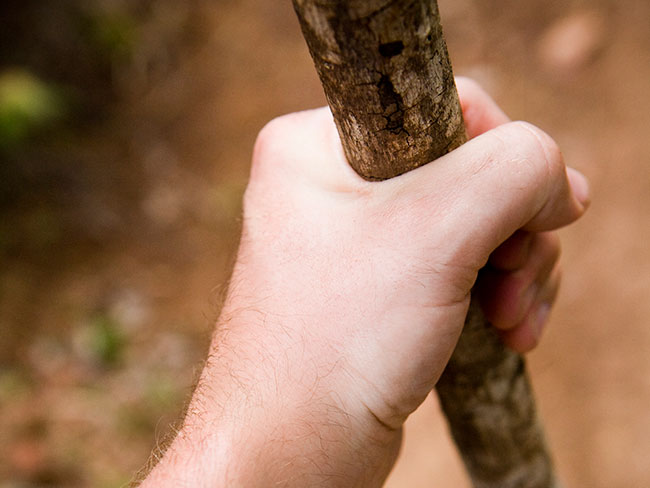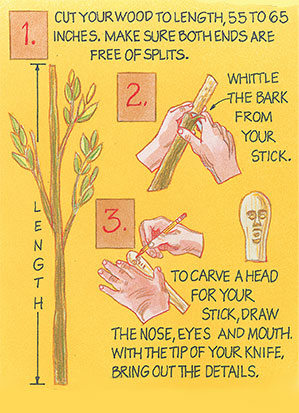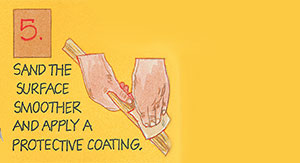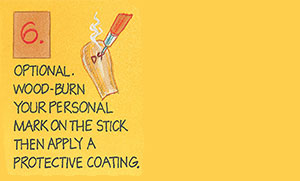How to Make Your Own Hiking Stick

Walking sticks make hiking more fun. Also called hiking poles or hiking staffs, they let your arms get into the act, so you cover ground more easily. Even better, they help you keep your balance, which means that heavy pack will stay on your back instead of tumbling down some deep ravine — and maybe taking you with it! Here’s how to create your own walking stick or hiking pole.
WHAT YOU’LL NEED:
- A straight tree or tree branch that’s 1-1⁄2 to 2 inches thick at its big end, and 55 to 65 inches long (DO NOT CUT ANY TREE; see Step 1.)
- A 1-inch-long piece of 3⁄4-inch diameter copper water pipe
- Five-minute epoxy glue
- A small saw to trim the stick to its final length
- A sharp pocketknife
- A spokeshave and a wood-burning tool (both optional)
- Adult help and/or supervision
WHAT YOU’LL DO:
 Step 1: Cut your wood to length, making sure both ends are free of splits.
Step 1: Cut your wood to length, making sure both ends are free of splits.
You can use dead, dry wood, but it’s hard to carve and makes a weak walking stick. If possible, use fresh wood; hardwood from deciduous (leafy) trees is better than evergreen softwood because it is less gummy.
To choose the right size, stand with your arms at your side and the stick should be about 6 or 8 inches taller than your elbow. Pick an even longer stick if you’ll be tackling steep terrain. If you’re really just planning on walking with your stick, a shorter one will do.
Note: Scouts never cut just any live tree! Take wood only from approved sources, such as a conservation project that thins out a timber stand or trail-building and trail-improvement projects.
Step 2: Using your pocketknife, whittle the bark from your stick, revealing the bright wood beneath. This job takes patience, especially when you are working around knots. Keep at it. You may discover your stick has an inner layer of bark, as well. Carve it away too, or your stick will darken as it dries.
Step 3: Now is the time to carve a head for your stick, if you want one. Using a pencil, draw on the nose, eyes and mouth, then slowly and carefully use the tip of your knife to bring out the details. If you rush this part of your work, you risk slipping and cutting yourself.
 Step 4: To protect the bottom end of your walking stick from splintering, whittle it down until the piece of copper pipe slips snugly onto it. Secure the pipe permanently with five-minute epoxy.
Step 4: To protect the bottom end of your walking stick from splintering, whittle it down until the piece of copper pipe slips snugly onto it. Secure the pipe permanently with five-minute epoxy.
 Step 5: Your walking stick is now ready for immediate use. However, if you’d like to carve it to a smoother finish and apply a protective coat, you’ll need to let it dry indoors for about a month. Use sandpaper or a spokeshave (if you have one) to make its surface even smoother.
Step 5: Your walking stick is now ready for immediate use. However, if you’d like to carve it to a smoother finish and apply a protective coat, you’ll need to let it dry indoors for about a month. Use sandpaper or a spokeshave (if you have one) to make its surface even smoother.
 Step 6: Optional: Add your personal mark to the walking stick using a wood-burning tool. When you have the stick carved to your satisfaction, apply a stain or other such finish and a protective coat of polyurethane.
Step 6: Optional: Add your personal mark to the walking stick using a wood-burning tool. When you have the stick carved to your satisfaction, apply a stain or other such finish and a protective coat of polyurethane.
Take your walking stick with you on all your hikes. Whenever you pick it up, the stick will remind you of your past outdoor adventures and make you wonder what excitement lies ahead.
yesterday i made my own walkin stick it was fantastic!
A walking stick can serve as a great memento of a Scouting adventure, especially if it is made of a wood native to the area visited. A natural hiking stick can also be used to teach new Scouts about respecting the outdoors – since no Scout or Cub Scout would ever cut a live tree for a walking staff. That would go against the Outdoor Code and the Leave No Trace Guidelines. One of the best comments I heard from my Pack this past summer was: “these hiking sticks are great, and even better, they were FREE!”
Another way to attach a strap is to use a Klemheist knot (Google it). This has the advantage of being adjustable and removable. It also keeps you from having to drill, nail, staple or otherwise damaging your stick. Yes, it even works with webbing.
If you drill a small hole just above the “handle”, on your stick, then pull a peice of thong or cord (doubled up of course), with a piece of wire, through the hole; then tie a large knot on the loose end, then put some Elmers glue in the hole and pull the knot partway through so that the glue and thong set in place, you should have no problems putting a strap or handle on your stick. Walking sticks are part of the Woodcarving Merit Badge course that we teach at our Council summer camp each year, this trick works for us.
A great place to find sticks for walking sticks is beaver huts/dams. Be careful when walking around them. You can also find sticks pushed up on shore around the huts. The beavers already strip the bark off and you can find some really great starter walking sticks!
use a coping saw to take off the branches and then sand then.
My cub scout troop made walking sticks and they loved them, we used turkey and duck feathers from a local farm. we also carved arrow heads and used leather and laced woden beads. my troop loved this and we plan on doing one each year for our new comers.
Anybody have any ideas about the best way to attach a wrist strap to the stick. I was thinking about just screwing a loop of webbing to it but would be intersted in any better ideas.
I haven’t made one of these myself, but my mom’s friend gave me one that I could carve on at our school craft fair. This project looks really fun and I can’t wait to d it myself. There are plenty of trees in my backyard, so I think it’s going to be pretty easy to get a tree branch. Also, I might consider wood-burning my walking stick, because I have already done that with my dad. Awesome idea! 🙂 😉
I go tenting with my family all the time and my walking sticks are just kinda picked up on the way and end up being fire wood on askadent